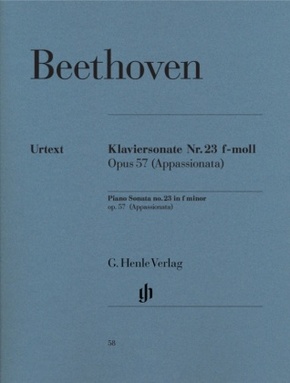Ludwig van Beethoven - Klaviersonate Nr. 23 f-moll op. 57 (Appassionata) - Besetzung: Klavier zu zwei Händen
| Verlag | Henle |
| Auflage | 2000 |
| Seiten | 30 |
| Format | 23,5 x 30,9 x 0,4 cm |
| Gewicht | 136 g |
| Reihe | G. Henle Urtext-Ausgabe |
| ISBN-13 | 9790201800585 |
| Bestell-Nr | 06567636BA |
Die Appassionata ist neben der Mondschein- und der Waldstein-Sonate wohl Beethovens berühmteste Klaviersonate. Nach letzterer stellt sie einen neuen Höhepunkt in Beethovens Klavierschaffen dar. Lenins auf sie gemünzter Ausspruch "Solche Wunderwerke können Menschen schaffen" ist im Grunde nichts hinzuzufügen. Der Beiname Appassionata, der eigenartigerweise erstmals in einer 1838 beim Verlag Cranz in Hamburg erschienenen Übertragung der Sonate für Klavier zu vier Händen auftauchte, stammt nicht von Beethoven, ist jedoch untrennbar mit dem Werk verbunden. Zu gut passt er offenbar zu den dramatischen Gegensätzen des ersten, zur feierlichen Innigkeit des zweiten und zur dämonischen Leidenschaft des dritten Satzes.
Inhaltsverzeichnis:
Klaviersonate (Appassionata) f-moll op. 57
Next to the Moonlight and the Waldstein Sonatas, the Appassionata is no doubt the most celebrated of Beethoven's piano sonatas and claims, with the latter two works, a new high point in the composer's piano oeuvre. With even Lenin weighing in with the words: "Such miraculous works can only be made by man," what is there left to say!
Curiously, the nickname Appassionata appeared for the first time in 1838 in a transcription of the sonata for piano four-hands published by the Cranz Verlag in Hamburg; although this designation did not originate with Beethoven, it is nowadays inseparably connected with the work. It fits splendidly with the dramatic contrasts of the first movement, the solemnity and inwardness of the second and the demonic passion of the third.
Inhaltsverzeichnis:
Piano Sonata (Appassionata) f minor op. 57

